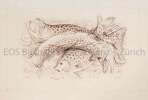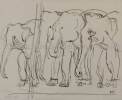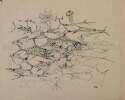-
Type
Any type (2)
Art print (7)
Book (31133)
Disk (1)
Drawings (7)
Engraving (9)
Magazine (129)
Old papers (1)
Photographs (14)
Posters (4)
-
Latest
Last 24h (6)
Last 3 days (127)
Last month (306)
Last week (13)
-
Language
Dutch (1)
English (54)
French (31206)
German (6)
Italian (18)
Japanese (2)
Portuguese (9)
Spanish (11)
-
Century
16th (16)
17th (57)
18th (209)
19th (1554)
20th (9340)
21st (1680)
-
Countries
Belgium (9630)
Brazil (7)
Canada (108)
China (3)
Côte d'Ivoire (67)
Denmark (218)
France (18209)
Germany (1)
Greece (1)
Italy (37)
Switzerland (3026)
-
Syndicate
ALAC (99)
CLAM (42)
CLAQ (94)
CNE (3)
ILAB (10650)
NVVA (1161)
SLACES (1161)
SLAM (8122)
SNCAO (9)
Der schwarze Hahn.
Bildausschnitt: 47 x 29 cm. 1951. Farbige Lithographie von Hans Fischer (fis).
Scheidegger 164. – Im Stein signiert und mit Nachlassstempel.
Der schwarze Hahn. Zweifarbige (schwarz-rot) Lithographie.
1951. Bildausschnitt: 47,2 x 30 cm.
Scheidegger 164. – 2. Zustand, Hahnkörper mit weissen eingekratzten Linien. Vom Künstler bezeichnet «II. Zustand, einzige Probe vor der 4 farb. Auflage – Stolzer Hahn».
Der Teufel stürzt vom Turm.
Blattgrösse: 29,5 x 21 cm. Um 1950. Tuschzeichnung.
Unten links vom Künstler mit Bleistift beschriftet: «Der Teufel stürzt vom Turm». Unten rechts und rückseitig mit Nachlassstempel.
Der Vogel. Kreidelithographie, über Holzmaserplatte gezeichnet.
1958. Bildausschnitt: 74 x 36,5 cm.
Scheidegger 354.– Unten vom Künstler mit Bleistift beschrift «Vogel-Mensch» und nummeriert, 14/30. – Wurde 1959 vom Kunsthaus Zürich als Plakat verwendet.
Der Vogel. Kreidelithographie, über Holzmaserplatte gezeichnet.
1958. Bildausschnitt: 74 x 36,5 cm.
Scheidegger 354.– Unten vom Künstler mit Bleistift beschrift «Probe col.» und nummeriert, 14/30. Probedruck mit blauen Ergänzungen.
Der Vogel. Kreidelithographie, über Holzmaserplatte gezeichnet.
1958. Bildausschnitt: 74 x 36,5 cm.
Scheidegger 354. – Unten mit Bleistift nummeriert: 18/30. – Rückseitig mit Nachlassstempel.
Der Vogelmensch.
Bildausschnitt: 47,5 x 23,7 cm. Kreidelithographie auf Velin von Hans Fischer (fis).
Schheidegger 353.- Unten vom Künstler mit Bleistift bezeichnet: "Probe". Leicht stockfleckig. Rechter Rand beschädigt.
Der Vogelmensch. Lithographie.
1958. Bildausschnitt: 47,5 x 23,7 cm.
Scheidegger 353. – Unten mit Bleistift nummeriert: 14/XX. Rückseitig mit Nachlassstempel. – Blatt leicht fleckig.
Die Lockvögel. Radierung.
1957. Plattengrösse: 15,5 x 11 cm.
Scheidegger 338. – Rückseitig mit Nachlassstempel.
Die "siebenköpfige" Besatzung. Tuschzeichnung.
Blattgrösse: 29,6 x 21 cm.
Unten vom Künstler mit Bleistift beschriftet: «Die siebenköpfige Besatzung (wird abglöst) (gestrichen)». Unten links signiert.
Die Vögel. Farblithografie.
1958. Bildausschnitt: 48,2 x 30 cm.
Scheidegger 352. – Unten vom Künstler mit Bleistift bezeichnet «Probe». – Rückseitig mit Nachlassstempel.
Drei Clowns.
Bildausschnitt: 20,5 x 31,5 cm Um 1951. Bleistirftzeichnung von Hans Fischer (fis).
Gerahmt.
Drei Fische. Steinradierung.
1946. Biildausschnitt: 22,4 x 35,5 cm.
Scheidegger 75. – Unten vom Künstler signiert und nummeriert: 7/200.
Drei Hahnstudien.
Blattgrösse: 23,5 x 15 cm. Bleistift- und Farbstiftzeichnung von Hans Fischer (fis).
Rückseitig vom Künstler mit Bleistift beschriftet: "Drei Hahnstudien". Unten in der Mitte und rückseitig mit Nachlassstempel.
Drei Vögel. Farbige Kreidelithographie mit Holzstruktur im Hintergrund.
1958. Bildausschnitt: 58,6 x 40 cm.
Vgl. Scheidegger 351 (ohne Hintergrund). – Im Stein signiert. Rückseitig mit Nachlassstempel.
Drei Vögel. Kreidelithographie.
1958. Bildausschnitt: 58,6 x 40 cm.
Scheidegger 351. – Unveröffentlichter Illustrationsentwurf zu Aristophanes – Die Vögel. Unten mit Bleistift bezeichnet «Probe». – Rückseitig mit Nachlassstempel.
Elefantendressur. Bleistiftzeichnung auf Pergamin.
Bildausschnitt: 20 x 14 cm. 1951. Bildausschnitt: 20 x 14 cm.
Vgl. Scheidegger 156, vom Künstler signiert.
Elefanten. Tuschzeichnung auf Pergamin.
Blattgrösse: 21 x 26 cm. Um 1945.
Rechts unten mit Nachlassstempel. - Linker Rand mit kleinem Einriss.
Er haut über die Schnur. Tuschzeichnung.
Blattgrösse: 21 x 14,8 cm.
Oben vom Künstler mit Bleistift beschriftet: «er haut über die Schur ...» und unten rechts signiert. - Auf Halbkarton montiert.
Eule auf einem Ast. – Waldkauz die Eule.
Bildausschnitt: 43 x 27 cm. 1952. Kreidelithographie von Hans Fischer.
Scheidegger 200. - Unten vom Künstler mit Bleistift signiert, bezeichnet «Waldkauz» und «Probe».
Fels und Wolke. Farb- und Bleistiftzeichnung.
Blattgrösse: 31,5 x 24 cm. Spanien, 1956.
Mit Bleistift signiert, datiert und bezeichnet.
Fische.
Blattgrösse: 37,3 x 52,5 cm. Um 1953. Farbstiftzeichnung auf Pergamin von Hans Fischer (fis).
Mit Nachlassstempel.
Fische. Tuschzeichnung auf Pergamin.
Blattgrösse: 28,4 x 35 cm
Unten rechts mit Nachlassstempel.
Fischmann (Le Diable-Poisson). Pinsellithographie.
1954. Bildausschnitt: 69,4 x 31,5 cm.
Scheidegger 265. – Probedruck in Schwarz. Unten vom Künstler mit Bleistift beschriftet: «Fischmann, vergrössert für Plakat, ohne Farben». Im Stein signiert. – Wurde 1954 vom Kunsthaus Zürich als Plakat verwendet. – Rückseitig mit Nachlassstempel.
 Write to the booksellers
Write to the booksellers























